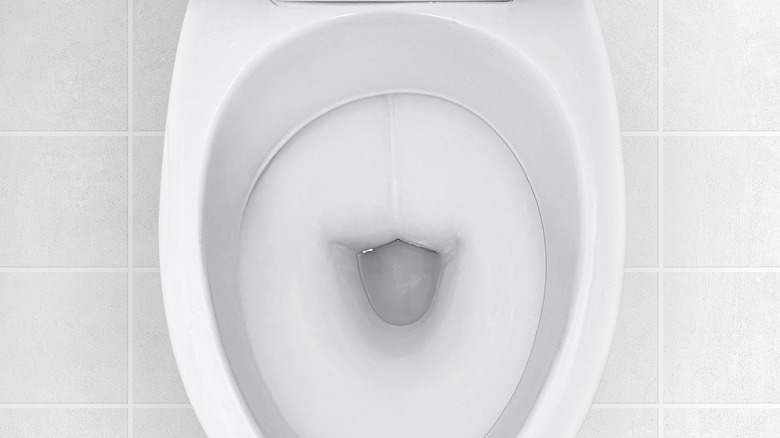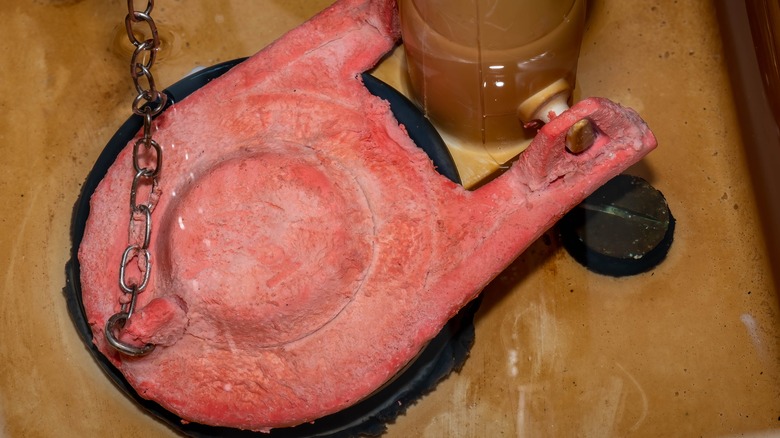What To Do If Your Toilet Bowl Isn't Holding Water
We may receive a commission on purchases made from links.
The toilet is one of those home appliances that you would prefer that it works properly every time without having to think about it. Other than having to clean your toilet naturally and regularly, it should just work. However, there are times where you discover a problem with the toilet that you should not ignore. One such issue occurs when the bowl simply can't hold water. Sure, the toilet could work if the bowl is low or empty, as you can pour a bucket of water into it to create a gravity flush, but this is a hassle that you shouldn't have to do. Plus, the fact that the bowl will not hold water can be a sign of a serious problem with the appliance that could lead to a bigger problem soon.
Some of the causes of a toilet bowl failing to hold water are fixable yourself through a quick adjustment or DIY hack. Other times, you need the help of a plumber. Because toilet repairs can cost anywhere from $150 to $400 with the help of a plumber, you'll surely be tempted to try to fix the issue yourself first. Understand, however, some issues with low water in the bowl may not be fixable, meaning you need to spend an average of $350 to $950 for the new toilet and another roughly $375 for the installation from a plumber.
Simple solutions to fix a toilet bowl that won't hold water
One potential fix for a toilet bowl that is continually low on water is to adjust the position of the float, which is the mechanism inside the upper tank that cuts off the flow of water into the tank when it reaches the desired level. However, if the float is cutting it off too quickly, the flow of water from the tank into the bowl won't be enough to fill the bowl. Look at the level inside the tank, which should fill to within an inch or two below the top of the overflow tube. If it isn't reaching this level, adjust the screws or dials on the float until it reaches the desired level of fill.
Another situation that you probably can fix yourself occurs when the toilet has a leaky flapper. The flapper is the rubber piece that blocks water from going from the tank into the bowl. When you flush, the flapper lifts out of place to allow water movement. After a few seconds, the flapper drops back into the hole, creating the seal. If it's constantly leaking, the bowl's water level may frequently appear low. You can replace the flapper for about $7 at Amazon. You also should check the chain attached to the flapper, as it could simply be tangled and preventing a proper seal, negating the need for replacement.
Another potential cause of a bowl that constantly has a low level of water occurs when the inlet holes, or rim jets, are clogged. These jets, which sit under the rim of the bowl, allow water to run from the tank into the bowl. A clogged jet may not allow the water to fully enter the bowl. Turn off the water to the toilet and flush to empty the tank and bowl. Clean these jets by pouring vinegar into the bowl and scrubbing the vinegar up and under the rim.
When the low water level in the toilet bowl may unveil a more serious problem
Unfortunately, having low water levels inside the toilet bowl could indicate a significant issue that simply isn't fixable, such as a crack in the porcelain. You may not even notice a hairline crack, yet it could be causing water to leak away. To diagnose this issue, look for moisture sitting on the floor near the appliance that doesn't have an explanation. If the crack is below the normal fill level, this is probably the cause of the leak. Unfortunately, it is not a fixable issue and requires a new toilet installation. It can be challenging to find a tiny crack. Clean the porcelain thoroughly inside and out. Then shut off the water to the toilet and flush until it is completely empty. When looking for these cracks, look for something that resembles a piece of hair.
Finally, your toilet may be leaking because the wax ring beneath the toilet is failing. These can be replaced, but the toilet needs to be removed to do so. This may be a job better left to a plumber, since you want to make sure the new wax ring is situated properly and the toilet is re-installed securely.


